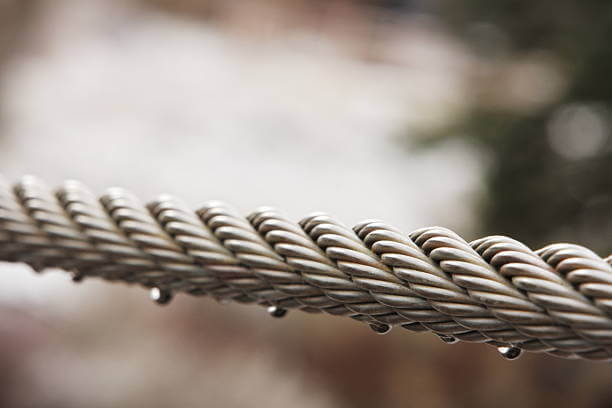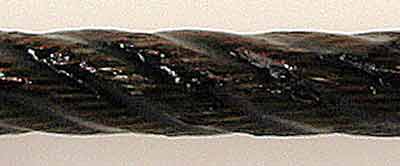Rust on your winch cable compromises safety by weakening the metal strands, increasing the risk of snapping under tension — a major hazard during recovery operations. This guide explains five proven methods to prevent rust and prolong the life of your winch cable.
Quick Summary:
- Clean your winch cable thoroughly after every use, especially in saltwater conditions.
- Apply a rust-resistant lubricant to create a moisture barrier.
- Use a UV-resistant sleeve to protect against sun damage and trail debris.
- Let your cable dry completely before storage to prevent internal corrosion.
- Inspect for rust spots regularly and address early signs immediately.
How to Keep Winch Cable From Rusting: 5 Ways
1. Keep the Cable Clean.

It’s critical to rinse off your winch cable after every use, especially if it was submerged in water.
Saltwater is especially corrosive to metal cables because of its high salt content.
You may not realize it, but debris and dirt also get lodged between the inner strands of the cable during winching.
Use a stiff brush made specifically for cleaning winch cables to scrub the exterior of the line.
Applying elbow grease” is an informal expression. A more neutral phrase fits better in a professional guide.
The abrasive brush bristles will knock off the particles without damaging the metal wire strands.
Getting down between the inner strands is just as important to dislodge grime and moisture. You can soak sections of the cable in a bucket of water mixed with cable cleaning solution to loosen the buildup.
Using gloved hands, massage and agitate the submerged portion vigorously. The motion helps dissolve sediment so it rises off the strands below.
The main goal is to fully displace any trapped particles that can abrade the metal over time or trap moisture against the steel.
Even microscopic debris creates crevices for water to pool against the strands, accelerating corrosion and rust.
That’s why thorough scrubbing to remove every grain of sand, fleck of gravel, or other contaminants is time well invested after each use.
While cleaning winch cables takes a bit more effort than a simple rinse, regularly getting down to bare metal helps prevent premature rust and damage.
Proper maintenance gives your winch cable the longest possible working lifespan and keeps it operating safely in all conditions.
2. Apply Cable Lubricant

After thoroughly cleaning your winch cable, the next critical step is to apply a protective lubricant.
The lubricant creates a moisture-displacing barrier on the steel strands to prevent corrosion.
Regular application after each cleaning keeps the metal conditioned over time.
The lubricant essentially seals out humidity and water that could otherwise reach the cable’s surface.
This is possible because most cable lubricants contain solvents that dissolve moisture and oils that cling tenaciously to metal.
The oily protective layer then prevents rust from gaining a foothold even in damp or wet conditions.
In addition to corrosion protection, cable lubricants reduce friction on the individual wire strands as the line spools onto the drum.
Less friction means less wear and tear during operation. This significantly extends the functional lifespan of your winch cable over years of use.
When shopping for cable lubricant, look for solutions designed specifically for winch lines rather than standard lubricating oils.
The best formulations have a viscous, almost tacky texture that allows them to tenaciously cling to the strands rather than drip off over time. This offers long-lasting moisture protection exactly where it’s needed most.
Among the top-rated lubricants preferred by off-roaders are Boeshield T-9 and lithium grease sprays for winching.
Silicone-based sprays also work well at sealing out moisture and can handle extreme temperatures. Just remember to reapply after getting the cable wet or every few months to maintain protection.
Properly lubricating a cleaned winch cable is the final seal against rust and corrosion.
Using cable-specific formulas shields each tiny strand from water, friction, and wear—ensuring maximum performance for years of winching.
3. Use a Winch Line Sleeve
A winch line sleeve is an essential cable protection accessory that shields your cable from environmental exposure when not in use. Think of it like a protective jacket for your cable.
You simply slide the sleeve over the coiled winch cable already spooled onto the drum. The sleeve encases the full length of cable, mitigating damage from UV rays, abrasion, dirt, grease, oils and other threats.
The sleeve itself is made of a thick, durable UV-resistant material like woven nylon or polyester. It needs to withstand years outdoors in tough winching conditions without ripping or cracking.
High-density sleeves prevent moisture from seeping through to corrode your cable inside.
One of the biggest benefits a winch line sleeve provides is protecting against UV ray damage from sunlight. Over time, the sun’s rays can degrade the synthetic fibers stranded with steel cables.
This causes them to dry out and crack. The sleeve forms a complete UV barrier to prevent premature brittleness and fraying.
The thick material also shields against trail debris kicked up by tires that could abrade or cut your cable. Without a sleeve, gravel bits stuck in the drum can grind away line from the inside.
The sleeve catches and blocks this abrasive grit and other grime from direct contact.
When shopping for a sleeve, match it precisely to the length and diameter of your winch cable for full coverage.
Correct sizing ensures the sleeve stretches snugly over the line without sliding around loosely during transport and storage.
Getting an exact fit is essential for keeping your cable protected on and off the trails.
4. Store Properly After Use
Correctly caring for your winch cable between uses is just as important as field maintenance in preventing premature rust and wear.
The last step before storage is letting the recently-used line fully dry out.
After you finish winching for the day, it’s best to unwind the entire cable off the drum to “open it up”, similar to unwinding a hose.
Extend the full length and hang it vertically from something sturdy like a beam or tree branch. This allows moisture on the strands to naturally drip off rather than pool up.
Wet cables left coiled on the drum overnight invites corrosion inside the layers.
Allow the unwound cable to completely air dry before rewrapping. Dampness within strands generates the perfect environment for rust to brew undetected.
An infrared thermometer pointed at the line can confirm it has equalized to ambient temps.
Before re-coiling onto the drum, run a gloved hand along the cable’s length, feeling for any stuck debris or salt crystal buildup. Use a brush to gently knock off any final particles and apply lubricant to the surface.
Avoid aggressive brushing on dry cable which accelerates abrasion damage.
The final step is recoiling the winch line neatly to prevent kinks or knots. Maintain light tension as you evenly wind it onto the drum in smooth, flat layers. Binding the layers too tight strains the inner strands which leads to early failure.
Finish by protecting the coiled cable with a durable, UV-resistant winch line sleeve. The sleeve acts as a protective barrier, blocking humidity, dust, and grime from contacting the surface.
Keeping debris out preserves your winching investment between jobs. Proper drying, cleaning and sleeving prevents corrosion, so your cable stays in top condition for years of reliable service.
5. Frequently Inspect for Rust
Frequently inspecting your winch cable for early signs of rust is critical to preventing irreparable damage down the road. Make it part of your post-use and pre-storage cable care regimen.
Closely examine the cable’s full length, paying special attention to sections that get abraded while pulling loads. Signs to look for are any brown rust spots forming or blistered areas revealing surface corrosion underneath.
Even a pinhole breach in the protective lubricant barrier can allow moisture infiltration.
Use a rag soaked in cleaning solution to vigorously scrub suspect areas and determine if light rust just affects the surface or if pits have formed infecting inner steel strands.
Catching issues early means you can neutralize with lubricants before major structural issues arise.
However, if you uncover extensive rust networks with flaking or powdery oxidation, the cable integrity is likely compromised and should be replaced.
Temporary fixes at this stage typically backfire. Deep internal corrosion causes individual steel strands to eventually snap under load.
When one strand fails, it piles excessive load onto the remaining intact strands, cascading into cable failure. The whipping metal can inflict serious injury and leaves you stranded out on trails. Don’t take chances trying to stretch the lifespan on a badly rusted cable.
Replacing severely rusted winch cables as soon as you detect extensive damage keeps everyone and your rig safe. Early detection through frequent inspection combined with proper lubricating maintenance delivers maximum return on your cable investment.
Stay ahead of corrosion before it deteriorates safe winching capacity when you need it most off-road.
Conclusion
Keeping your winch cable rust-free takes some regular TLC using these prevention tips. But a well-maintained cable is absolutely vital for safe and reliable winching.
The small amount of effort pays off tremendously whenever you need to use your winch without worrying about sudden line failure! Utilize cleaning, lubrication, storage and frequent inspection steps to maximize the lifespan of your steel or synthetic winch rope.
Your off-road rig will thank you next time you need to winch yourself out of a sticky situation!

